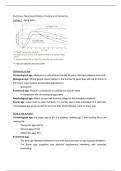Summary
Samenvatting - Neuropsychology of aging and dementia (PSB3E-CN06)
- Course
- Institution
The summary consists of all the lectures and the readings per week that had to be read. Together, the readings and the lectures form the literature for the exam, which is all summarized in this summary. The summary explains the most important concepts, includes examples and images to clarify ce...
[Show more]



